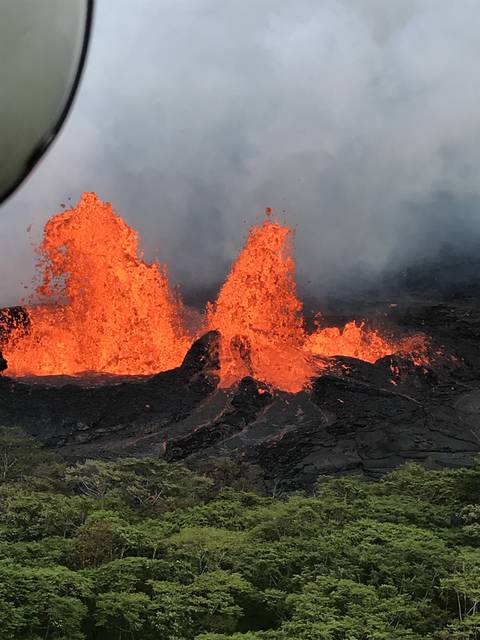The chief of state Emergency Management agency, who’s heading up the governor’s and mayor’s task force on Puna Geothermal Venture says he should know soon if efforts are successful to neutralize KS-14, the last “active” well at the lower Puna geothermal power plant.
“We have quenched 10 of 11 wells and we are pumping fluid to plug the last well as we speak,” Tom Travis said during the afternoon media briefing on the Puna lava emergency. “Should have an idea whether or not that’s successful tonight. Once that step is taken, we will be in a much more solid state for having lava overflow the site. This is important, because I think, as all of you know, lava is starting to intrude on the southern edge of Puna Geothermal Venture site. It’s not easy to predict where it’s going to go or when it’s going to get there.
County Civil Defense said this morning lava from fissure No. 22, which is currently feeding the ocean entry near MacKenzie state park, is also going in the opposite direction toward the beleaguered geothermal plant, which has been shut down since the current lava emergency began on May 3. Officials said the lava had come to within 200 to 300 yards of PGV’s well pad, but had been slowed or stopped by a berm. Officials said as of this afternoon, the lava hadn’t advanced closer to the well pad.
Travis said “quenching the wells” means filling them with enough cold water so the weight of the water is more than the pressure from the volcanic steam below can overcome, effectively of cooling the well. He said once the well is neutralized, it can be capped with a mud-like substance that hardens or with a metal cap. Travis said metal well caps are either in Honolulu or Kona, and will be brought to the site for installation by tomorrow.
According to Travis, the other wells at the plant were responding to the infusion of water, but KS-14 remained hot despite the best efforts of the crew of about a half-dozen skilled workers. He said mud was now being pumped into KS-14 and expressed optimism that the work, if successful, would hold up if the well pad was overrun by lava, but said a worst-case scenario would involve a large release of hydrogen sulfide (H2S), a colorless, highly flammable and toxic gas.
Travis said he thinks a worst-case scenario would carry less severe consequences than the blowout of well KS-8 while it was being drilled on June 12, 1991, which caused what an independent technical investigation by the University of North Texas described as “the unabated release of steam for a period of 31 hours before PGV succeeded in closing in the well.”
The hydrogen sulfide stench, which has a rotten-egg smell, prompted the evaucation of nearby residents and noise, which was described as like a jet airplane taking off, reached 90 decibels. One worker suffered a minor injury in the blowout.
Travis said no one has been injured in the current effort to cap the plant’s geothermal wells.
See Tuesday’s Tribune-Herald for a complete story.

